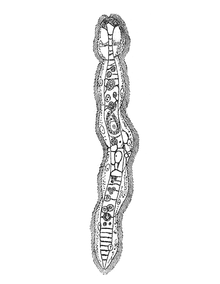Vermiform

Vermiform describes something shaped like a worm. The expression is often employed in biology and anatomy to describe more or less tubular or cylindrical, usually soft body parts or animals. The word root is Latin, vermes-worms and formes-shaped.[1] A well known example is the vermiform appendix, a small, blind section of the gut in humans and a number of other mammals.[2]
A number of soft-bodied animal phyla are typically described as vermiform. The more well known one are undoubtedly the annelids (earthworm and relatives) and the roundworms (a very common, mainly parasitic group), but a number of less well known phyla answer to the same description. Examples range from the minute parasitic mesozoans to the larger bodied free-living phyla like ribbon worms, peanut worms and priapulids.
References
- ↑ Glare, edited by P.G.W. (1982). Oxford Latin Dictionary (Combined ed., repr. with corr. ed.). New York: Oxford University Press. ISBN 0-19-864224-5.
- ↑ Smith H. F., Fisher R. E., Everett M. L., Thomas A. D., Bollinger, R. R., Parker W. (2009). "Comparative anatomy and phylogenetic distribution of the mammalian cecal appendix". Journal of Evolutionary Biology. 22: 1984–1999. doi:10.1111/j.1420-9101.2009.01809.x. PMID 19678866.